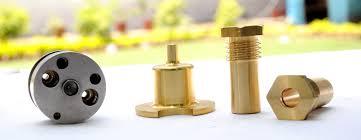In the realm of manufacturing, brass inserts stand out as indispensable components used across various industries for enhancing the functionality and longevity of assembled products. These small but mighty inserts serve a multitude of purposes, from strengthening threaded connections to providing durable mounting points in plastic components. In this comprehensive guide, we'll explore the world of brass inserts , discussing their applications, advantages, manufacturing processes, and why they are preferred in modern industrial settings.
Understanding Brass Inserts
Brass inserts, also known as threaded brass inserts or brass threaded inserts, are small metal components designed to be embedded or pressed into a pre-drilled hole in a substrate, typically plastic or wood. Once installed, they provide a secure and durable threaded anchor point for fasteners such as screws, bolts, or threaded rods. Brass inserts come in a variety of shapes, sizes, and thread configurations to accommodate different applications and assembly requirements.
Applications Across Industries
Brass inserts find application across a wide range of industries, each benefiting from their unique properties and versatility.
1. Electronics: In the electronics industry, brass inserts are commonly used to provide secure mounting points for printed circuit boards (PCBs), electronic components, and housings. Their excellent electrical conductivity ensures reliable grounding and connectivity in electronic devices and assemblies.
2. Automotive: Brass inserts play a vital role in automotive manufacturing, where they are used to reinforce threaded connections in plastic components such as dashboard panels, interior trim, and engine covers. Their corrosion resistance and high strength make them ideal for withstanding the rigors of automotive environments.
3. Furniture and Cabinetry: Brass inserts are widely used in the furniture and cabinetry industry for assembling wooden or composite panels, drawers, and joints. They provide a sturdy and reliable anchor point for attaching hardware such as handles, knobs, and hinges, enhancing the structural integrity and longevity of furniture pieces.
4. Consumer Goods: From appliances and sporting equipment to toys and household gadgets, brass inserts can be found in a myriad of consumer products. Their versatility and ease of installation make them a preferred choice for manufacturers looking to improve the durability and functionality of their products.
Advantages of Brass Inserts
The widespread adoption of brass inserts can be attributed to several key advantages:
1. Enhanced Strength and Durability: By providing a threaded metal anchor point in a substrate, brass inserts significantly improve the strength and durability of threaded connections. This is especially beneficial in applications subject to vibration, stress, or frequent disassembly and reassembly.
2. Corrosion Resistance: Brass inserts exhibit excellent corrosion resistance, making them suitable for use in outdoor, automotive, and marine environments where exposure to moisture, chemicals, and harsh weather conditions is common.
3. High Electrical Conductivity: In electronic applications, brass inserts ensure reliable electrical grounding and connectivity, contributing to the overall performance and safety of electronic devices and assemblies.
4. Versatility and Customization: Brass inserts are available in various sizes, thread configurations, and installation methods, allowing for customization to suit specific application requirements. Whether it's heat-set, press-in, or ultrasonic installation, there's a brass insert solution for every need.
Manufacturing Processes
Brass inserts are typically manufactured through precision machining or cold forming processes. Precision machining involves cutting, drilling, and tapping brass rod stock to create inserts with precise dimensions and thread profiles. Cold forming, on the other hand, involves shaping brass wire or rod stock using specialized dies and punches, resulting in inserts with excellent surface finish and dimensional accuracy.
Conclusion
Brass inserts may be small in size, but their impact on product performance and reliability is significant. From electronics and automotive to furniture and consumer goods, brass inserts play a crucial role in strengthening threaded connections, providing durable mounting points, and enhancing the overall quality of assembled products. With their superior strength, corrosion resistance, and versatility, brass inserts remain a preferred choice for manufacturers seeking to optimize the performance and longevity of their products in today's competitive marketplace.
